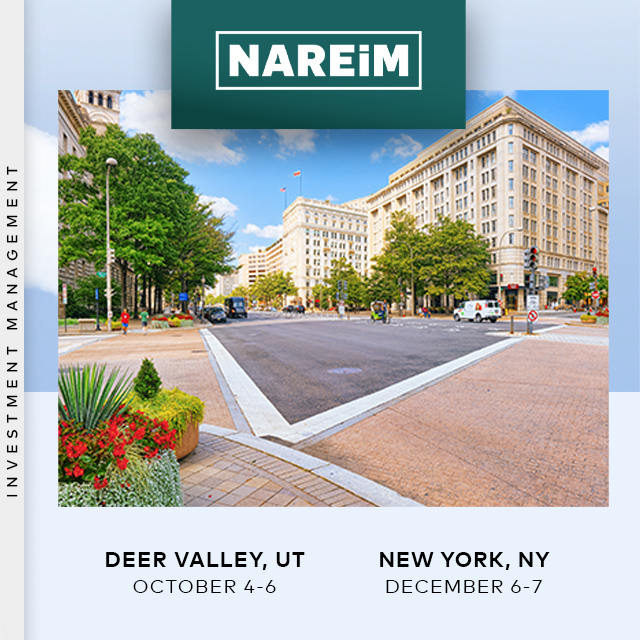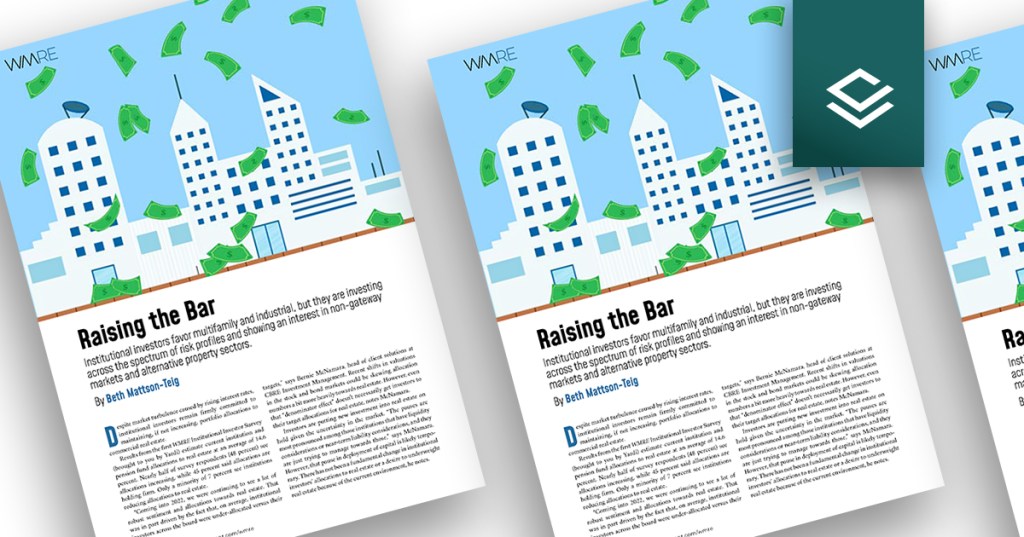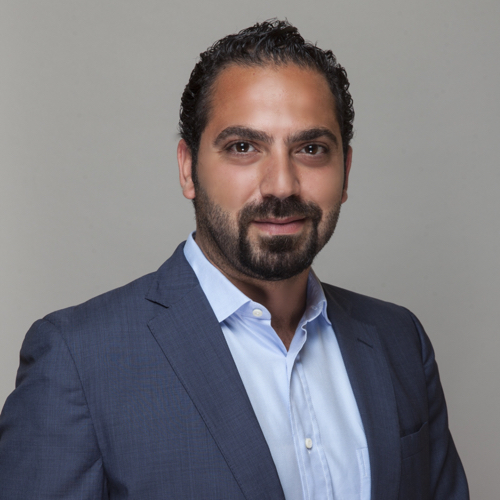Since its founding in 1990, NAREIM has promoted best practices for real estate investment management with an array of education, networking, research, thought leadership and student program opportunities. Yardi has consistently supported NAREIM events as a sponsor, exhibitor and presenter over the years. Close out 2023 on a high note by joining the Yardi Investment Suite team at these dynamic NAREIM events: Event: NAREIM Executive Officer Meeting Date: Oct. 4-6 Place: Deer Valley, Utah Summary: Roundtable sessions and group discussions on building effective relationships, creating organizational strategies, and meeting the challenge of finding the right skills for asset management, transactions and portfolio management. Extras: Alpine slide and tubing down the 90K ski jump at the Park City Olympic Village. Meet with Yardi: Fill out a contact form. Event: NAREIM Capital Raising & IR Date: Dec. 6-7 Place: New York CitySummary: NAREIM Capital Raising & Investor Relations committee update, followed by sessions on managing ESG and DEI issues, elevating fundraising skills, raising capital from non-institutional sources and looking ahead to 2024. Extras: Networking dinner at the Liberty Bistro in downtown Manhattan. Meet with Yardi: Fill out a contact...
Yardi IM on the Road
Q4 Events Preview
The Yardi Investment Management team has a full slate of events across the country as the 4th quarter beckons. Along with cosponsoring several of these major industry forums and conferences, Yardi sends expert teams to demonstrate the value of the Yardi Investment Suite, an end-to-end technology platform that automates the real estate investment lifecycle. Key upcoming real estate investment events include: IMN Real Estate CFO & COO Forum Date: Oct. 2 Place: New York City Geared toward CFOs, COOs, tax and accounting officers, controllers and treasurers, the 11th annual staging of this event offers insights from real estate developers, lenders, REITs and operating companies. Sessions focus on trends in accounting, regulations and technology, along with fund raising, the power of AI and more. See more event information. IMN Real Estate Family Office and Private Wealth Management Forum Date: Oct. 4-5 Place: Miami This event showcases opportunities in the family office asset class, which allocates about 15% of its portfolio to real estate direct investments. This forum is suited to asset managers, debt and equity financiers, family business owners and investment consultants, among others. Learn more and meet with the Yardi team. IMN Middle-Market Multifamily Forum West, Northeast and Arizona Date: Sept. 19-20 (West), Oct. 10 (Northeast), Nov. 13-14 (Arizona) Place: Carlsbad, Calif. (West), New York (Northeast), Litchfield Park, Ariz. (Arizona) Targeting small and mid-sized multifamily owners and operators, these deep dives explore issues, opportunities, strategies and trends that impact a class that comprises 75% of all multifamily investors. Value-add strategies, working with institutional capital and the “acquisitions shark tank” are among the industry leader-led sessions on tap. Learn more about the Carlsbad, New York and Litchfield Park events. Learn more about the industry events that Yardi participates in as a sponsor, expert and...
New RE Investment Insight
In Yardi/WMRE Report
Real estate represents stability and remains a cornerstone investment option in an era of increasing economic uncertainty, according to the inaugural WMRE Institutional Investor Survey of real estate industry participants across the U.S. The survey was sponsored this year by Yardi and originally published by WMRE magazine. As a measure of the industry’s standing as an investment asset, more than 90% of respondents to the survey – which canvassed high-net-worth family advisors, private real estate investors, pension fund managers, institutional investors and life insurance companies – anticipate holding or increasing their real estate allocations. Just 7% anticipate that institutions will reduce such allocations. Instability in the stock and bond markets has spurred investors to value real estate for its status as a stable asset, a portfolio diversifier, a hedge against inflation and a steady source of income. “Real estate tends to be less volatile and more consistent” than stocks and many other assets, the report notes. Multifamily, industrial widely favored The survey also reveals institutional investors’ favored real estate markets, with multifamily (preferred by 67% of respondents), industrial (47%) and data centers (36%) leading the way. The $154.6 billion in multifamily sales in the first half of 2022 represented about 41% of all property transactions in that period, with industrial coming in second with $74.6 billion. The office and retail sectors were rated favorably by 14% and 12% of survey respondents, respectively, reflecting the reduced need for central physical work locations during the pandemic. Broadening geographic focus Whereas institutions traditionally favored the six gateway cities – San Francisco, Los Angeles, New York, Boston, Washington and Chicago – investment activity now encompasses some 25 other top markets, principally Sun Belt areas with more affordable living. Growing metros previously considered secondary, such as Phoenix, Seattle and Denver, are receiving more attention from investors. “What COVID did was really rip off the cover and accelerated the movement of … institutional money to those places where people were already moving,” Jeff Adler, vice president of Yardi Matrix, notes in the report. Investment tech’s role expands Although only 35% of survey respondents use an investment management system to calculate promotes, waterfalls and other structures, “a number of factors are driving technology further into the industry,” the report says, including growing demand from institutional clients for real-time data and analytics. This set of expectations has given rise to automated investment management systems that connect information from the asset level through the investment structure to the investment with a previously unattainable degree of efficiency. Other topics covered in the report include: Key factors that influence institutional investors’ allocations to real estate.The investment vehicles most and least in favor among real estate investment managers.Niches within the office world that are impressively outperforming the general office market.The annual rate of return that institutional investors seek from their real estate investments. Get details on these issues and more by downloading the full WMRE...
Tulsa Real Estate Fund
Investment Opportunities for All
Did you know that about 90% of millionaires built their wealth through real estate? Between 1932-2012, however, the average American faced multiple barriers to entry for real estate investment. New laws limited participation in investments, placing a hurdle between small-time investors and wealth. Crowdfunding, legalized in 2012, is a relatively new opportunity for people with limited income to invest in large projects. It permits accredited and unaccredited investors to build wealth through real estate and other investments. The Tulsa Real Estate Fund (TREF) was the first African American owned and managed regulation A+, two-tier real estate investing crowdfund in American history. Its initial purpose was to help low-income families participate in real estate investments that build wealth and combat gentrification. Since then, it has expanded its services to accredited and unaccredited investors. Barriers to entry for low-income families and minorities TREF is a nod to the nation’s past when communities invested together to achieve success against all odds. In the early 1900s for example, the predominately black community of Tulsa, Oklahoma used small group investments to development the town. Conventional lenders would not serve black communities, yet new industries, businesses and families flourished thanks to collective investments. The Greenwood District of Tulsa became so successful that it was called Black Wall Street. Group investments helped the town overcome discriminatory lending practices, but the community would soon face a larger hurdle. In 1921, Tulsa experienced a wave of domestic terrorism later known as the Tulsa Race Riots and the Tulsa Massacre. Though the catalyst is still under dispute, the event resulted in the deaths of as many as 300 African Americans, 800 injuries, and 35 city blocks bombed and set ablaze by white mobs and the National Guard. The events destroyed Black Wall Street and left many families homeless and without a source of income. Tulsa was not the first or the last successful black town to be destroyed by a combination of economic sabotage and domestic terrorism. Following the Great Depression, low-income and minority investors would face new challenges. The Security and Exchange Commission took shape. It is credited for protecting investors from schemes that were rampant during economic recovery. Simultaneously, it hindered how lower-income families could participate in the recovery: investors were required to receive accreditation, the guidelines for which demanded a net worth in excess of $1,000,000. It would be 80 years before an organization like TREF brought large-scale investments back into the hands of the average American. Forming TREF From the end of the Great Depression to 2012, low-income families and minorities were limited in investment opportunities and success due to a combination of domestic terrorism, economic interference and new laws. In 2012, the Obama administration signed the Jumpstart Our Business Startups (JOBS) Act into law. The JOBS Act creates opportunities for people and organizations to participate in investments and publicly raise funds from accredited and unaccredited investors. This new era of crowdfunding lay the foundation for The Tulsa Real Estate Fund, where investments begin as low as $500 at $50 per share. The organization was named to honor the entrepreneurial spirit of Tulsa’s Black Wall Street. It is aimed to highlight the correlation between small investments, real estate and the will to succeed against the odds. TREF founder Ernestine Johnson explained, “The goal of the Tulsa Real Estate Fund, which I cofounded with my husband, is to spread a message of financial empowerment and financial literacy in underserved and working-class communities.” The women propelling TREF Around 2017, Johnson learned that the median net worth for black women in her age range was $500. “This did not sit right with me,” recalled the television actress. “I was standing on $1,000 shoes. I said to myself, ‘I have to use my art and my voice to financially empower low income, underserved and urban communities,’” said Johnson. Johnson recruited Johnetta Paye to form TREF. Paye is the owner...
UAE Update
The rise of REITs
The Gulf Cooperation Councill (GCC) has witnessed significant growth in the number of real estate investment trusts (REITs) across the region, with over seven publicly listed REITs established to date. Since 2006, regulations have perm itted REITs in the Dubai International Financial Centre (DIFC), but previous market downturns delayed any real progress within this particular sector of real estate. The first REIT in the United Arab Emirates (UAE) was established in 2010. More recently in the UAE, ENBD REIT and the Emirates REIT were listed on NASDAQ Dubai with market capitalisations of $261 million and $289 million respectively. In other GCC countries, such as Bahrain and Kuwait, there are now private REITs with total sizes of $80 million and $100 million, respectively. The introduction of REITs in Saudi Arabia by the Capital Market Authority (CMA) in 2016 was part of the National Transformation Program (NTP) and Saudi Vision 2030. This included a regulatory framework with a minimum of 100 million Saudi riyals ($26.67 million) capital for REITs, and borrowing not rising above 50 percent of the fund’s total asset value. The market in Saudi Arabia is divided between two REIT investment strategies, the mixed-asset and the specific-asset class approach, with a tendency towards the specialisation of REITs, along with a focus on asset classes that are common to the region, such as office, retail, education, healthcare and logistics. The making of the REIT The goal of the REIT is to provide investors with access to high-grade, low-risk, income-generating real estate assets. About 45 percent of investment professionals in the region see the GCC’s real estate market as mature enough for REITs to surge. Although tax efficiency has less impact on the REITs in the GCC, it offers liquidity and flexibility for investors and real...





